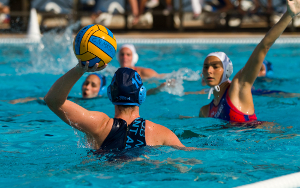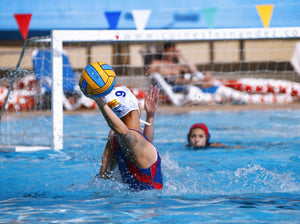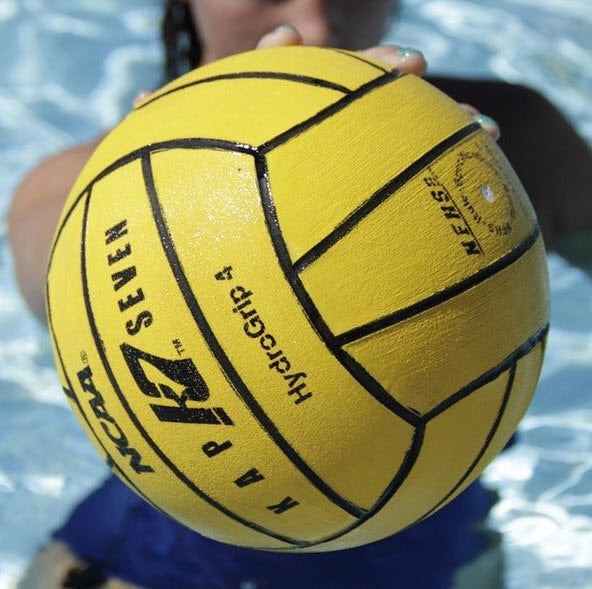Basic Water Polo Defense
 Water polo players on defense have two main objectives: To prevent the offense from shooting and to steal the ball. While this is a fairly straightforward, there are many subtleties regarding defensive strategy, how to guard certain players, and when to foul. Learning the basics — proper body position, how to keep track of the ball and a player at the same time — set the stage for more complex defensive maneuvers down the road. This guide explains the most basic and important aspects of standard water polo defense.
Water polo players on defense have two main objectives: To prevent the offense from shooting and to steal the ball. While this is a fairly straightforward, there are many subtleties regarding defensive strategy, how to guard certain players, and when to foul. Learning the basics — proper body position, how to keep track of the ball and a player at the same time — set the stage for more complex defensive maneuvers down the road. This guide explains the most basic and important aspects of standard water polo defense.
Body Position
Body position plays a huge role in determining the effectiveness of a defender. If an offender can easily swim around you to the goal or receive passes, you are not in the correct position. No matter where you are in the water or who you are guarding, the following guidelines apply.
Keep Your Hips Up
As a defender, you need to keep your hips up and maintain a strong eggbeater at all times. Keeping your hips up enables you to quickly change position, such as when a player from the other team takes off on a drive or slides into a new position after a play. High hips also make it easier to pop up and intercept a pass or block a shot. Lastly, letting your hips drop means you can be turned and will have a less powerful start on a counterattack.
Stay in Defensive Lanes
You may often hear a coach on deck yell “Get in in a lane!” That means you need to position your body in a way that provides optimal coverage and mobility. In a defensive lane, your hips and legs point towards the goal while your head stays between the offender and the ball. Constantly keeping your head between the player and the ball makes it difficult for the offender to get open for a pass, while keeping your hips at the surface of the water and pointing towards the goal will allow you to quickly change direction, follow drivers, or drop back on the hole set.
Just remember: Keep your head between the player and the ball, and your body between the player and the goal. As the ball moves around the offense, you will need to change your head position. Keep track of where your offender is by maintaining light physical contact.
Maintain Physical Contact
Water polo is a contact sport. Don’t be afraid to keep tabs on the player you are guarding by lightly resting a hand on their shoulder, arm, or back. Remember that you cannot obstruct them if they are trying to move and if you are being too physical (and they aren’t holding the ball), a foul may be called.
If your player is touching the ball, nothing you do to them will draw a foul (barring anything needlessly violent). However, as soon as they drop the ball and you are still playing them physically, a foul may be called.
How to Defend Drivers
Anyone guarding a ****perimeter player**** is guarding someone with the potential to drive. Drives, picks, and plays are the best way an offense can get players open for passes and shots, so a good defense will be prepared. Defenses can guard man-to-man (most common), by zone, or in a dropback defense. In each of these cases, the defense will need to communicate to ensure constant coverage.
Keeping Drivers Out of Inside Water
Drivers want one thing: To get inside water. Their defenders want one thing as well: To keep the offense from getting inside water. Because defenders cannot physically obstruct an offensive player, their best alternative is to control the direction of the drive. That means using body position to force the driver away from the middle of the goal or to the weak side.
Also known as a gross-and-go, a grab-and-go is when a defender guards a perimeter player too closely and the perimeter players grabs their arm, yanks it back, and pulls themselves towards the goal. This effectively leaves their defender in the dust (or bubbles).
Switching
Switching occurs most often when your team is playing a zone-based defense, although it still makes sense occasionally in man-to-man or drop defenses. A switch is just what it sounds like. As a flat drives down and a wing slides up to fill their position, you and the flat’s defender can “switch” players by staying in position rather than following whomever you were originally guarding. Switches should only be made if the defensive coverage doesn’t suffer as a result. Thus, read the situation and make sure your teammate knows you are switching.
Dropping & Crashing
Rather than playing man-to-man, many offenses opt to drop or crash back. This means that defensive players take turns dropping back towards the hole set to help block shots and prevent passes. It also means that the remaining two defenders at the top must guard three people. These defenders cover the players who are the biggest threats: The player with the ball, the players closest to the goal, or the ones on the strong side.
Defending the Hole Set
The hole’s defender (also known as “hole D”), has an especially challenging job. They guard the position with the best access to the goal, usually filled by one of the strongest players on the opposing team. Because offensive action revolves around the hole set, the hole D will need to have endurance, know how to foul correctly, and be prepared to play very physically. More grabbing and underwater fighting happens in these two positions than anywhere else in the pool.
Hole Ds can front the set or guard them regular (put themselves between the hole set and the goal). Hole Ds also need to tell their team if they need help, or if the hole set’s defensive strategy has changed.
Defense Is More than Just a Break from Offense
Most beginning players and their coaches spend the bulk of their time on offensive strategies. There is certainly no shortage of things to learn about water polo’s offense, but neglecting defense is a serious mistake.
In an evenly matched game, players spend 50 percent of their time on defense, so making a solid defense is just as valuable as having a strong offense. Because defense leads to an important understanding of how water polo works, it shouldn’t be thought of as “a break from swimming and driving,” but instead a chance to shut down the other team’s offense and take advantage of their weaknesses.



